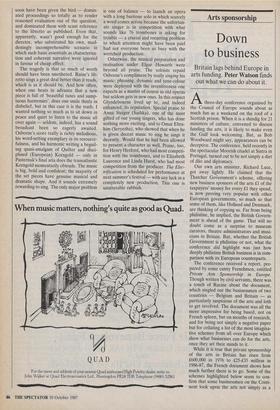Arts sponsorship
Down to business
Athree-day conference organised by the Council of Europe sounds about as much fun as a weekend on the roof of a Scottish prison. When it is a shindig for 21 ministers of culture, convened to discuss funding the arts, it is likely to make even the Gulf look welcoming. But, as Bob Woodward might say, appearances can be deceptive. The conference, held recently in the spectacular Moorish citadel at Sintra in Portugal, turned out to be not simply a diet of dao and diplomacy.
Our own arts minister, Richard Luce, got away lightly. He claimed that the Thatcher Goliernment's scheme, offering new business sponsors of the arts £1 of the taxpayers' money for every £1 they spend, is now proving very popular with other European governments, so much so that some of them, like Holland and Denmark, are thinking of copying us. Far from being philistine, he implied, the British Govern- ment is ahead of the game. That will no doubt come as a surprise to museum curators, theatre administrators and musi- cians in Britain. But, whether the British Government is philistine or not, what the conference did highlight was just how deeply philistine British business is in com- parison with its European counterparts.
The conference received a report, pre- pared by some canny Frenchmen, entitled Private Arts Sponsorship in Europe. Though written by civil servants, there was a touch of Racine about the -.document, which singled out the businessmen of two countries — Belgium and Britain — as particularly suspicious of the arts and loth to get involved. The document was all the more impressive for being based, not on French spleen, but on months of research, and for being not simply a negative paper but for collating a list of the most imagina- tive schemes from all over Europe which show what businesses can do for the arts, once they set their minds to it.
While it is true that private sponsorship of the arts in Britain has risen from £600,000 in 1976 to £25-£35 million in 1986-87, the French document shows how much further there is to go. Some of the schemes highlighted below seem to con- firm that some businessmen on the Conti- nent look upon the arts not simply as a form of advertising or PR but as a source of enjoyment.
Austria's largest bank, Creditanstalt, co-operates with two leading publishers. It guarantees to buy a given number of copies of certain books which it donates to clients as gifts. (These are serious books, not bland PR.) The Landesbank owns a theatre of its own. The company which runs the theatre is a wholly owned subsidi- ary and owns the building in which the playhouse is located. The Zentralspar- kasse, a Vienna bank, owns a collection of 6,000 contemporary paintings which it is constantly up-dating. The bank uses its 150 branches to exhibit this art on a regular basis.
In Spain, the Bank of Bilbao owns 17 halls for cultural promotion. El Banco Exterior owns an art gallery and recently financed the post of assistant conductor to the national orchestra of Spain. The sav- ings institutions in Spain between them own 500 exhibition halls, 300 concert halls and 400 libraries. Explosivo Rio Tinto collects 20th-century Spanish masters and publishes fine art books.
In France, Alfa Romeo commissioned ten artists to produce original works. It then paid for lithographs to be made of these works, which were exhibited in every Alfa dealer's showroom in the country. Customers were given the chance to win the art works in a competition. The Casino chain of supermarkets has invested £1.2 million in the new modern art museum at St Etienne.
Italian firms are allowed to donate pre- tax profits for conservation of old buildings without ceiling. Under this scheme, Olivetti has paid for the restoration of Leonardo da Vinci's 'Last Supper' in Milan and the Brancacci Chapel in Florence. Savings banks are obliged by law to contri- bute part of their profits to social or cultural works and as a result publish between them 300 books a year. These are mostly serious art books which are pre- sented to clients, libraries and research institutes. The Turin Savings Bank has funded the Cinema Museum to the tune of E1 million.
A popular idea, already used in Ireland and Spain, and which Greece hopes to introduce, is a national lottery with the proceeds devoted to health, education and the arts. Richard Luce himself favours a lottery for Britain, but not all his col- leagues in the Cabinet do. If such a measure went through, officials at the Office of Arts and Libraries estimate it would add between £.5 million and £10 million to the arts budget.
Without it, more business sponsorship is the only hope for more cash to the arts, as the minister has said time and again. However, one of the main arguments against business sponsorship is that firms can pull out at any time, making long-term projects difficult. The Council of Europe's document at least gives some examples of long-term commitment to the arts on the parts of many banks, savings institutions and industrial manufacturers.
Mr Luce may be content that the 'pound-for-pound' scheme is working well and has its imitators abroad. But, to ensure the continued health of the arts in Britain, some of these European schemes could well be encouraged here.



























































 Previous page
Previous page